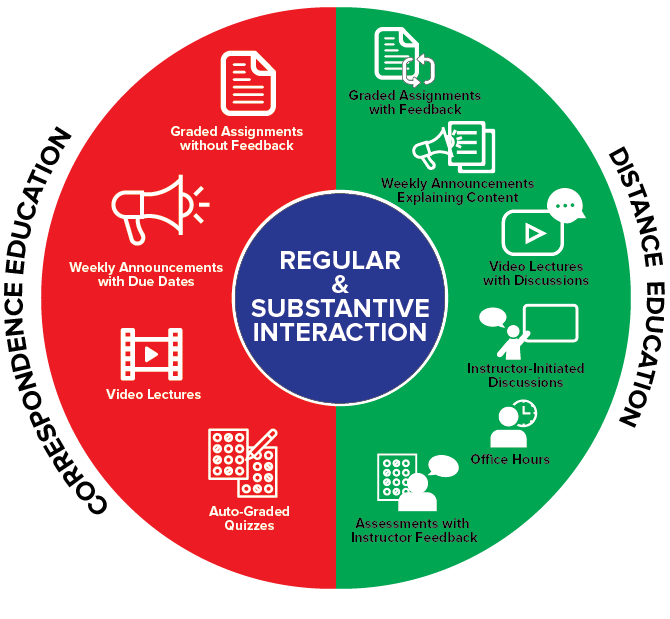Regular and Substantive Interaction (RSI)

What to know about RSI!
As of July 1, 2021, the U.S. Department of Education clarified and codified regulations for Regular and Substantive Interaction (RSI) in distance education. These requirements help distinguish distance education, which qualifies for federal financial aid, from correspondence education, which does not.
The purpose of RSI is to distinguish distance education, which is eligible for federal financial aid, from correspondence education, which is not. Universities and colleges offering distance education courses (where most instruction happens online) must meet specific Regular and Substantive Interaction (RSI) requirements. These requirements, set by the Department of Education, ensure students in online courses receive meaningful engagement with instructors and peers, similar to traditional classroom settings.
Benefits of RSI:
- Enhanced engagement: Regular interaction keeps students motivated and invested in the course.
- Deeper understanding: Substantive discussions and feedback help students solidify their grasp of concepts and develop critical thinking skills.
- Community building: Interaction fosters a sense of belonging and connection among students and instructors, creating a supportive learning environment.
- Improved learning outcomes: Studies have shown that courses with strong RSI lead to better academic performance and student satisfaction.
RSI plays a vital role in ensuring the quality and effectiveness of online education. By incorporating regular and substantive interactions, instructors can create dynamic learning environments that promote engagement, understanding, and success for all students.
Criteria for RSI
To meet RSI requirements, online courses must include documented evidence of instructor-initiated, regular, and substantive interactions, ensuring that students are engaged throughout the course duration.- Interactions must be instructor-initiated not student-initiated.
- Interactions may vary in mode and format but must be regular.
- Interactions must be substantive, not trivial in nature.
Regular & Substantive Definitions
An institution ensures regular interaction between a student and an instructor by:
- Providing the opportunity for substantive interactions with the student on a predictable and scheduled basis commensurate with the length of time and the amount of content in the course or competency.
- Monitoring the student’s academic engagement and success and ensuring that an instructor is responsible for promptly and proactively engaging in substantive interaction with the student when needed, on the basis of such monitoring.
Substantive interaction is engaging students in teaching, learning, and assessment, consistent with the content under discussion, and also includes at least two of the following:
- Providing direct instruction
- Assessing and/or providing feedback on a student’s coursework
- Providing information and/or responding to student questions about the course content
- Facilitating a group discussion regarding course content or competency
- Other instructional activities approved by SACSCOC
Some Examples and Nonexamples (not inclusive)
Please reference this document for more detailed examples of RSI
Examples of RSI-Compliant Interactions:
- ✅ Posting a discussion question and actively moderating responses by asking follow-ups, redirecting discussion, and clarifying misunderstandings.
- ✅ Hosting a scheduled live Q&A or feedback session via video or chat, with opportunities for student-instructor engagement.
- ✅ Providing personalized feedback on student assignments that includes guidance for improvement and deeper learning.
Examples of Non-RSI-Compliant Interactions:
- ❌ Posting a discussion board question but not engaging in follow-up interactions. (Fails to be substantive or instructor-initiated)
- ❌ Only posting reminders about deadlines without engaging in discussions, assessments, or instruction. (Fails to be substantive)
- ❌ Uploading recorded lectures without requiring student engagement, responses, or follow-up discussion. (Fails to be interactive)
References & Additional Resources:
- Negotiated rulemaking for higher education 2018-19. (2020, November 6). U.S. Department of Education. https://www.govinfo.gov/content/pkg/CFR-2023-title34-vol3/pdf/CFR-2023-title34-vol3-sec600-2.pdfhttps://www.ecfr.gov/current/title-34/subtitle-B/chapter-VI/part-600/subpart-A/section-600.2
- Federal Register listing of Amendments to the Higher Education Act of 1965, including Regular and Substantive Interaction:
https://www.federalregister.gov/documents/2020/09/02/2020-18636/distance-education-and-innovation - Poulin, R., & Davis, V. (2019, April 23). Interpreting what is required for “Regular and substantive interaction”. WCET Frontiers. https://wcet.wiche.edu/wp-content/uploads/sites/11/2023/03/Definitions-of-Distance-Education-March-2023-Report-1.pdf
- U.S. Department of Education issues final rules on distance education and innovation | NC-SARA. (2020, October 1). NCSARA. https://nc-sara.org/news-events/us-department-education-issues-final-rules-distance-education-and-innovation
- Regular and substantive interaction: An overview for instructors of online courses at Everett Community College. (n.d.). Everett Community College.
https://www.everettcc.edu/files/programs/elearning/Regular_and_Substantive_Interaction_Primer.pdf

